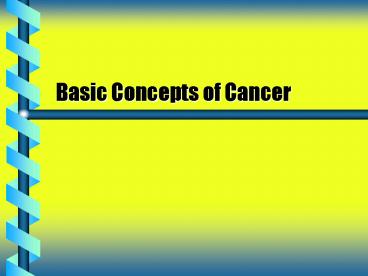Basic Concepts of Cancer - PowerPoint PPT Presentation
1 / 30
Title:
Basic Concepts of Cancer
Description:
... (p53 is #1 example) ... so need 2 hits Chemical damage to DNA Epigenetic modifications, base substitutions Aromatic hydrocarbons, aromatic amines Insecticides, ... – PowerPoint PPT presentation
Number of Views:135
Avg rating:3.0/5.0
Title: Basic Concepts of Cancer
1
Basic Concepts of Cancer
2
Neoplasia
- Disease of cell growth, division, and
differentiation - Benign tumors
- Localized, clear margins (encapsulated),
non-invasive, slow growing, well differentiated - Functional adenomas if glandular tissue
3
Malignant neoplasms
- Rapid growth, no clear margins (invasive)
- Aneuploidy, uncontrolled cellular multiplication,
lytic enzymes - Decreased cell adhesion, increased motility
(metastatic) - Angiogenesis---abnormal vessels
4
(No Transcript)
5
Classifications of malignancies
- Carcinoma--epithelial
- SarcomaCT or muscle
- Glioma--glial cells
- Neuroblastoma--neurons
- Lymphoma
- Leukemia
6
Cancer is a genetic disorder, but it is rarely
inherited
- Epigenetic modifications
- p53 proteinguardian of the genome
- Errors in p53 show up in 50 of all cancers
- Different mutations seem to prevail in different
cancers - Telomeraseprevents normal shortening of
telomeres at end of chromosomes - Absent in most somatic cells, present in 85 of
cancers - Allows for infinite number of divisions
7
Multi-step Model for Cause of Cancer
- One cell suffers multiple genetic mutations,
- Proto-oncogenes induce cell proliferation and
growth (normal function) - Defined by what happens when turned on
- Tumor suppressor genes suppress cell growth
- Defined by what happens when turned off
- P53--guardian of genome, halts faulty cycle
8
Initiation--promotion--progression theory
- Initiation is first insult or series of insults
to genome
9
(No Transcript)
10
Types of Initiation Steps
11
Changes in proto-oncogenes? oncogenes
- Point mutationsalways dominant (ras gene,
telomerase gene) - Gene amplification
- Chromosomal rearrangement
- Viral insertion and activation
- human papillomavirus, hepatitis B and C, Epstein
Barr (?)
12
Changes in tumor suppressor genes (p53 is 1
example)
- Removes controls on cell cycle
- Removes review/editing of DNA copying mistakes
- Typically recessive mutations, so need 2 hits
13
(No Transcript)
14
Chemical damage to DNA
- Epigenetic modifications, base substitutions
- Aromatic hydrocarbons, aromatic amines
- Insecticides, asbestos
- Anti-neoplastic drugs
- Aflatoxins
- Nitrosamines and nitrosamides in food, water
15
Physical damage to DNA
- Breaks, deletions, translocations
- Sunlight (ultraviolet)
- Radiation--therapy or diagnostic use
16
Predisposing factors
- Age, sex, heredity
- 15-20 of all cancers are caused by
infection(usually viruses) - Exposure to DNA damaging compounds
- Precancerous lesions
- Colon polyps
- Metaplastic cells
17
Promotion Proliferation
- Intracellular antioxidant enzymes should repair
damaged DNA - Apoptosis should remove damaged cells
- Cancers become more malignant with each
generation of transformed cells
18
- Immune surveillance by cytotoxic T cells should
remove transformed cells - Tumor associated antigens presented by MHC 1
molecules - Decrease in thymus activity with age means more
cancers in older individuals
19
(No Transcript)
20
Progression--becoming malignant
- Rate of growth depends on cell cycle time and
rate of angiogenesis - Epithelial cancers usually grow faster
- To metastasize, must separate from original
cluster of cells and invade blood or lymph vessel - Must penetrate basement membrane
- Metastasis is NOT inevitable once penetrate
vessels - First downstream capillary bed and lymph node are
most vulnerable
21
Clinical Manifestations of Cancer
- Fatigue is the 1 complaint
- Starts early, for unknown reasons
- May last months after tumor is gone
- Causes most severe decrease in quality of life
- Painmay not arise until late stages
- caused by compression local tissue, inflammation,
or nerve injury (therapy)
22
Cachexia
- Malnutrition from metabolic demands of tumor,
release of cachectin (TNF) - anorexia, weight loss
- weakness, anemia
23
Additional problems
- 60-80 of late stage cancer patients will
experience clinical depression - Lack of sleep
- Fear
24
Alterations in carbohydrate metabolism
- Tumors metabolize glucose anaerobically
- Patient must convert lactate back to pyruvate for
use - Higher than normal insulin suggests post receptor
abnormalities - Metabolic changes persist after tumor removal
- TNF will increase insulin resistance in body
25
Alterations in protein metabolism
- Patient loses muscle mass
- Resembles situation in burn/sepsis/hyperthyroid
patients - Protein metabolism shifts to support tumor
- Acute phase protein response--liver makes
proteins for tumor, not the body - Associated with poor prognosis
- Alterations in amino acid levels that persist
after tumor removal
26
Alterations in fat metabolism
- Decrease in fat synthesis, increase in lipolysis
- Lipid mobilizing factor found in urine
- Increases cAMP levels, acts like lipolytic
enzymes - TNF-alpha stimulates lipolysis
- High levels of ?-3 fatty acids may have benefit
27
Other complications
- Increased risk of infection due to leukopenia,
therapy - Anemia
- Bleeding disordersthrombocytopenia, vascular
invasion, therapy - Malnutrition from GI dysfunction
28
Prognosis
- Tumor Grading Systembased on microscopic exam of
cells by pathologist - I Well differentiated
- II Moderately well differentiated
- III Poorly differentiated
- IV Undifferentiated
29
Prognosis
- Staging the tumor
- Stages 1-4
- Depends on number of sites, involvement of lymph
nodes - Automatically get Stage 3 if tumor and/or mets
cross the midline or the diaphragm
30
Prognosis
- TNM Classification System
- Tumor 1-4 (based on size)
- Txcannot be assessed
- Tiscarcinoma in situ
- Nodes 0-3
- Metastasis 0-1
- Etiology of cancervarious cancers have specific
progressions

